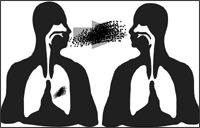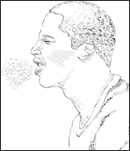Questions and Answers About TB
Introduction
What is TB?
Tuberculosis (TB) is a disease caused by bacteria called Mycobacterium tuberculosis. The bacteria usually attack the lungs. But TB bacteria can attack any part of the body such as the kidney, spine, and brain. If not treated properly, TB disease can be fatal. TB disease was once the leading cause of death in the United States.
TB is spread through the air from one person to another. The bacteria are put into the air when a person with TB disease of the lungs or throat coughs, sneezes, speaks, or sings. People nearby may breathe in these bacteria and become infected.
However, not everyone infected with TB bacteria becomes sick. People who are infected, but not sick, have what is called latent TB infection. People who have latent TB infection do not feel sick, do not have any symptoms, and cannot spread TB to others. But some people with latent TB infection go on to get TB disease.
There is good news. People with TB disease can be treated if they seek medical help. Even better, most people with latent TB infection can take medicine so that they will not develop TB disease.
Why is TB still a problem in the United States?
In the early 1900s, TB killed one out of every seven people living in the United States and Europe. Starting in the 1940s, scientists discovered the first of several medicines now used to treat TB. As a result, TB slowly began to decrease in the United States. But in the 1970s and early 1980s, the country let its guard down and TB control efforts were neglected. This led to an increase in the number of TB cases between 1985 and 1992. However, with increased funding and attention to the TB problem, there has been a steady decline in the number of persons with TB since 1993.
TB continues to be a problem. Multidrug-resistant TB (MDR TB) remains a concern, and extensively drug-resistant TB (XDR TB) has become an important issue. While the number of TB cases in the United States has been declining, there remains a higher burden of TB among racial and ethnic minorities. This is due to uneven distribution of TB risk factors that can increase the chance of developing the disease.
This booklet answers common questions about TB. Please ask your doctor or nurse if you have other questions about latent TB infection or TB disease.
How is TB spread?
 TB is spread through the air from one person to another. The bacteria are put into the air when a person with TB disease of the lungs or throat coughs, sneezes, speaks, or sings. People nearby may breathe in these bacteria and become infected.
TB is spread through the air from one person to another. The bacteria are put into the air when a person with TB disease of the lungs or throat coughs, sneezes, speaks, or sings. People nearby may breathe in these bacteria and become infected.
When a person breathes in TB bacteria, the bacteria can settle in the lungs and begin to grow. From there, they can move through the blood to other parts of the body, such as the kidney, spine, and brain.
TB disease in the lungs or throat can be infectious. This means that the bacteria can be spread to other people. TB in other parts of the body, such as the kidney or spine, is usually not infectious.
People with TB disease are most likely to spread it to people they spend time with every day. This includes family members, friends, and coworkers or schoolmates.
What is latent TB infection?
In most people who breathe in TB bacteria and become infected, the body is able to fight the bacteria to stop them from growing. The bacteria become inactive, but they remain alive in the body and can become active later. This is called latent TB infection. People with latent TB infection:
- Have no symptoms
- Don’t feel sick
- Can’t spread TB bacteria to others
- Usually have a positive skin test reaction or positive TB blood test
- May develop TB disease if they do not receive treatment for latent TB infection
Many people who have latent TB infection never develop TB disease. In these people, the TB bacteria remain inactive for a lifetime without causing disease. But in other people, especially people who have weak immune systems, the bacteria become active, multiply, and cause TB disease.
What is TB disease?
 If the immune system can’t stop TB bacteria from growing, the bacteria begin to multiply in the body and cause TB disease. The bacteria attack the body and destroy tissue. If this occurs in the lungs, the bacteria can actually create a hole in the lung. Some people develop TB disease soon after becoming infected (within weeks) before their immune system can fight the TB bacteria. Other people may get sick years later, when their immune system becomes weak for another reason.
If the immune system can’t stop TB bacteria from growing, the bacteria begin to multiply in the body and cause TB disease. The bacteria attack the body and destroy tissue. If this occurs in the lungs, the bacteria can actually create a hole in the lung. Some people develop TB disease soon after becoming infected (within weeks) before their immune system can fight the TB bacteria. Other people may get sick years later, when their immune system becomes weak for another reason.
Babies and young children often have weak immune systems. People infected with HIV, the virus that causes AIDS, have very weak immune systems. Other people can have weak immune systems, especially people with any of these conditions:
- Substance abuse
- Diabetes mellitus
- Silicosis
- Cancer of the head or neck
- Leukemia or Hodgkin’s disease
- Severe kidney disease
- Low body weight
- Certain medical treatments (such as corticosteroid treatment or organ transplants)
- Specialized treatment for rheumatoid arthritis or Crohn’s disease
Symptoms of TB disease depend on where in the body the TB bacteria are growing. TB disease in the lungs may cause symptoms such as:
- A bad cough that lasts 3 weeks or longer
- Pain in the chest
- Coughing up blood or sputum (phlegm from deep inside the lungs)
Other symptoms of TB disease are:
- Weakness or fatigue
- Weight loss
- No appetite
- Chills
- Fever
- Sweating at night
The Difference Between Latent TB Infection and TB Disease
| A Person with Latent TB Infection | A Person with TB Disease |
|---|---|
|
|
|
|
|
|
|
|
|
|
|
|
- Page last reviewed: December 21, 2012
- Page last updated: December 18, 2014
- Content source:


 ShareCompartir
ShareCompartir